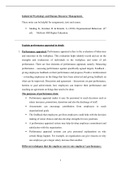Summary
Summary Assessing behavior in the workplace
- Institution
- University Of South Africa (Unisa)
Helpful notes for Human Resource Management and Industrial Psychology students. With terminology and concepts that can be helpful for assignments, tests and exams.
[Show more]



